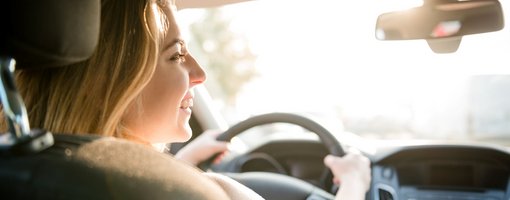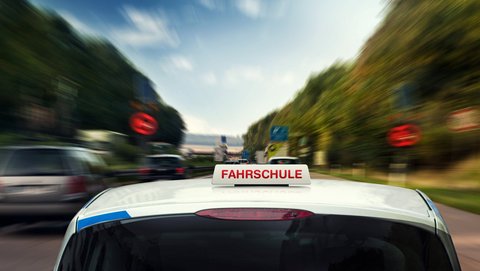The practical test: The procedure
How does the practice exam work? What needs to be considered before the examination? And what should I pay special attention to during the exam? Here we explain it to you.
After passing the theory exam, it is only a last step to your driving license. But this step commands respect from many students: The test drive. The better you know what to expect, the safer you'll feel. That is why we have described the procedure in detail here:

Before the test
- The examiner welcomes you and your driving instructor at the agreed test meeting point.
- First, he'll check your identity. Keep your identity card or passport handy.
- The examiner's documents also state whether you need a vision aid for driving. This means that you must put on your glasses at the latest now (contact lenses are of course also allowed).
- This is usually followed by a random safety check on the vehicle, e.g. checking the oil level, naming a control lamp or checking the tyre tread depth. Sometimes, however, these checks are only carried out at the end of the check.
- The examiner then explains the procedure of the test run. This includes the expectations of you and how the examiner gives you instructions during the journey.
- The examiner will take a seat behind you on the right so that he has a good view of you, the speedometer and the road. Your driving instructor sits as usual on the passenger seat next to you.
During the exam
- Driving technique preparation: These are the normal preparations you do at the beginning of each lesson. So adjust the seat, mirror and steering wheel. You also need to buckle up.
- Basic driving tasks: In addition to "normal" driving, you also have to prove your skills in various basic driving tasks. In category B, for example, this is parking, in the two-wheeler categories you have to go through a slalom again. Here you can see which basic driving tasks are required in your category.
- The examiner is instructed not to unnecessarily increase the student's mental stress. For example, there is no question of the significance of traffic signs. Possible mistakes will usually be communicated to you after the exam.
- Examination route: The examination route takes place both within and outside built-up areas. If there is a motorway nearby, it will be used as well. The ride takes place in the same area in which you completed your driving lessons. So you already know the "difficult corners" from your driving lessons and can take a look at DriversCam before your big day.
- During driving, the examiner shall pay particular attention to the following: steering wheel position, starting, gear changing, appropriate speed, traffic observation, traffic signs and equipment, distance to vehicle, overtaking, intersection, junction, roundabout and level crossing behaviour, turning and lane change behaviour, pedestrian behaviour, tramway and bus stop behaviour.
After the test
If the test is finished, you will be informed of the result immediately. If you pass the exam, you can usually take your driving licence with you and use it immediately. The only exception is if you took the exam before reaching the minimum age. Then you'll have to wait till your birthday.

Find your driving school
Do you want to start with your driver's license right away? Then find the driving school that suits you best in our search and ask your driving instructor all your unanswered questions about the practical exam.